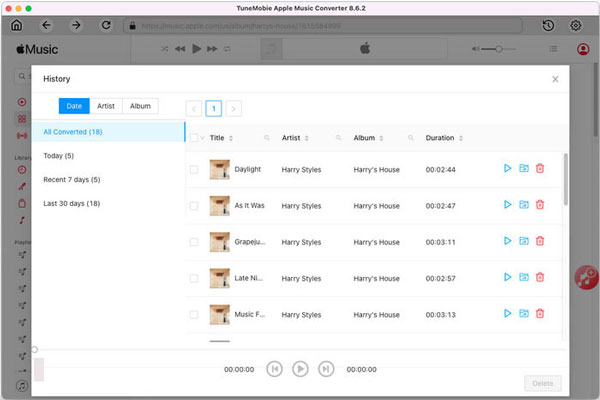How to Use TuneMobie Apple Music Converter for Mac?
![]() 日本語の操作ガイド(Japanese User Guide) >>
日本語の操作ガイド(Japanese User Guide) >>
The user guide of TuneMobie Apple Music Converter for Mac includes 3 parts as below. We also recommend you read the notes which may help you understand the changes better.
Part 1. The Limitations of Free Trial Version & How to register full version?
Part 2. How to upgrade to latest version in two free ways?
Part 3. How to use TuneMobie Apple Music Converter for Mac Step by Step?
From September 2022, we adopted the new way (built-in web player) to convert Apple Music songs. Compared to the old way, there are several benefits you can enjoy as below.
- This can avoid compatibility or crashing problems caused by iTunes/Music app version update or iTunes/Music app problems.
- This can avoid audio recording driver problem caused by antivirus application or system update.
- The conversion speed is now 20x faster. When using old way on macOS 10.14 or above, conversion speed is limited to 1X because of macOS system limitation.
Notes 1: The built-in web player is a broswer based on Google Chrome like many other browsers, however, you can only access to your own Apple Music library with the browser. And we will NEVER collect your personal information and it's also impossible for us to do that.
Note 2: You can still keep using the old way to convert songs. However, no further update of the old way will be provided. It may not work some day because of a certain iTunes/Music app version update.
Notes 3: Your registration status won't be changed. You don't need to register again after installing the new version.
Part 1. The Limitations of Free Trial Version & How to register full version
If you are using free trial version of TuneMobie Apple Music Converter for Mac, there are 2 limitations.
- You can only convert 3 minutes of each song.
- You can only convert 3 songs at a time.
If you have purchased a license from us, you will receive a registration code (license key) in your email box. You can follow the steps below to register full version and unlock all limitations.
Step 1: Launch TuneMobie Apple Music Converter on your Mac computer, you will see a key icon at the upper right corner of software interface. Click the key icon to pop up registration dialog. Or you can click menu Help > Register.

Step 2: Copy your registration code (license key) from your email box and paste it in the blank area of popup dialog.
Step 3: Click "Register" button at the lower right corner and you will see successful message in the top middle.

There are two notes you may need to pay attention to when registering full version.
- The registration code is a long string of upper-case letters and numbers. It is case sensitive.
- Internet connection is necessary to verify your license key.
Part 2. How to upgrade to latest version in two free ways?
1. Launch the product, go to menu bar, click menu "TuneMobie Apple Music Converter" > "Check for updates". If there is a new version, you will see a popup dialog. Click "OK" button to download the latest version. When downloading is done, install it to overwrite the old version and you will get the latest version. In fact, when you launch the program, it will pop up "Check for updates" dialog automatically if there is a new version.
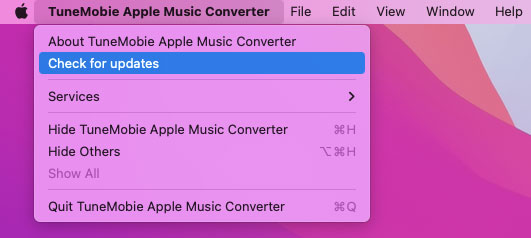
2. The "Free Trial" button on our website always links to the latest version. So you can always click "Free Trial" button to download the latest version. When downloading is done, simply install it to overwrite the old version, and you will get the latest version.
Part 3. How to use TuneMobie Apple Music Converter for Mac Step by Step
TuneMobie Apple Music Converter for Mac is extremely easy-to-use. You can simply launch the program, sign in your Apple ID, choose an output format, then add an album or a playlist and start conversion. However, the user guide below may help you learn more details of the conversion steps and options.
Step 1: Sign in built-in web player
After installation, launch TuneMobie Apple Music Converter and you will see a built-in Apple Music web player. There is a red "Sign In" button at the upper right with hint message that "Click here to login: Please click the button to log in your account". Click "Sign In" button, enter your Apple ID and password to sign in Apple Music web player.
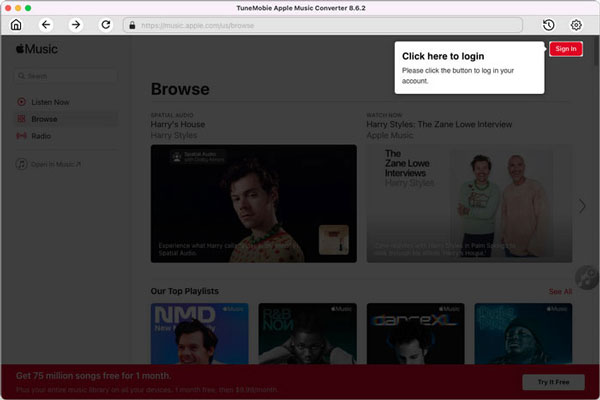
The message will be only displayed in the first launch or you have signed out your account from built-in web player and then signed in again. If you don't want to sign in every time you launch the program, please do not sign out the built-in Apple Music web player.
Step 2: Adjust output settings (Optional)
TuneMobie Apple Music Converter for Mac provides MP3, AAC (M4A), WAV, FLAC and AIFF output formats and Auto option. By default, output format will be set to Auto option, which is actually 256kbps M4A. If you want to change output format, you can click "Settings" icon at the upper right corner of software interface and select the format you want.
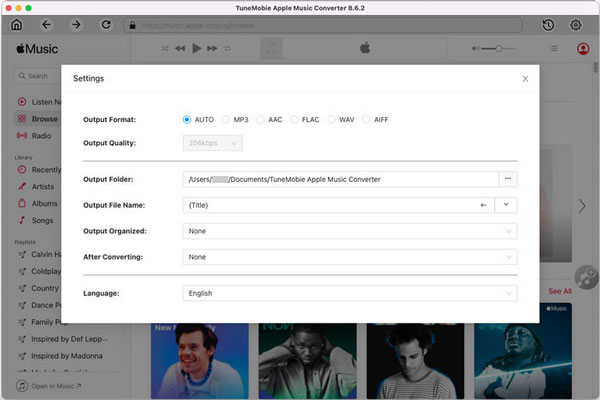
In Settings dialog, you can also change output folder, rename output files in batch, sort output files into folders, choose an action after conversion, and choose software interface language. It's recommended to adjust the settings before conversion.
In "Output File Name" list, you can use the tags {Title}, {Album}, {Artist}, {Track Number}, {Playlist Index}, {Space}, {-} and {Space-Space}. By default, you will only use {Title}, however, you can rename the output files flexibly like "{Artist}{Space-Space}{Title}", "{Album}{Space-Space}{Title}", "{Album}{Space-Space}{Track Number}{Title}", etc. You can use the left arrow to delete the tags and edit again.
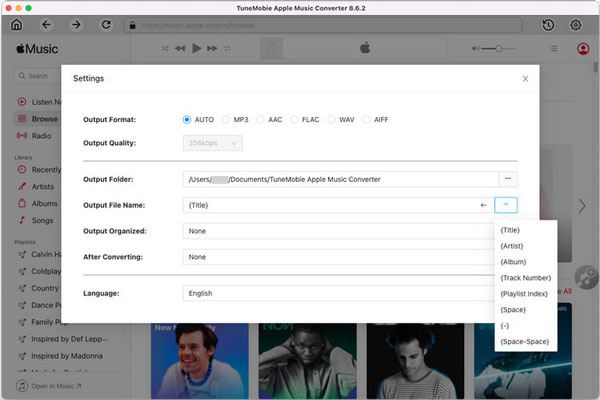
In "Output Organized" list, you can sort output files into Artist, Album, Artist/Album or Album/Artist folders or use "None" to put all the output files in the same folder. As to "After Conversion" list, you can choose "Open the output folder" or "Put the computer to sleep".
Step 3: Open an Album or a Playlist
In the built-in web player, on-screen message "Choose a playlist, artist or album and open it" will be displayed. Usually on-screen message will be only displayed in the first time or you have signed out and then signed in again. If necessary, you can ignore the on-screen message and click any other playlist or album you like. Now click your favorite playlist or album to open the detailed playlist/album page.
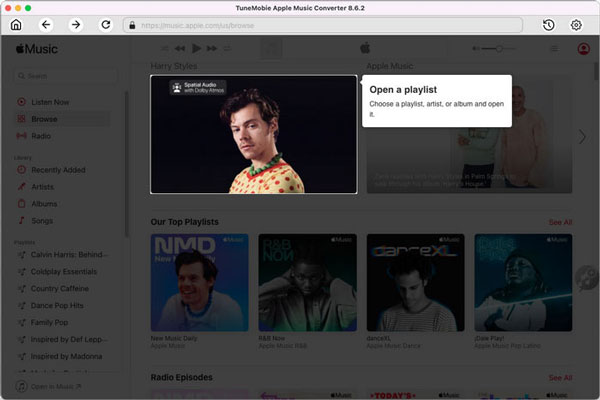
If it's not your first time to use this product, and you have signed in the built-in Apple Music web player, there should be no on-screen message on the interface. Click your favorite playlist or album to open the detailed page of the playlist/album.
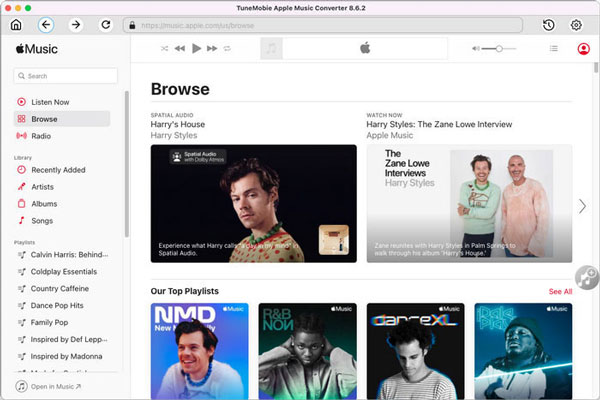
If you open an artist page, there should be multiple albums where you may need to click again in order to open the detailed album page.
Step 4: Add to Conversion List
In the detailed page of an album or a playlist, you will see an on-screen message which points to a music button with plus symbol in the middle right. You can simply click the button to add all the songs in the playlist or in the album to conversion list.
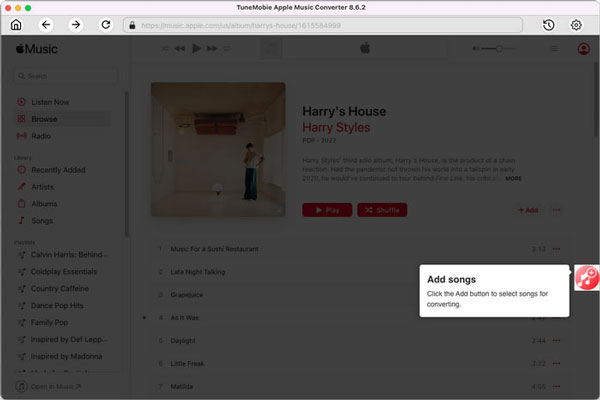
When there is no on-screen message, you can move your mouse to the button and it will be changed to "Add to list" button. Click "Add to list" button to add all the songs in the playlist or in the album to conversion list.
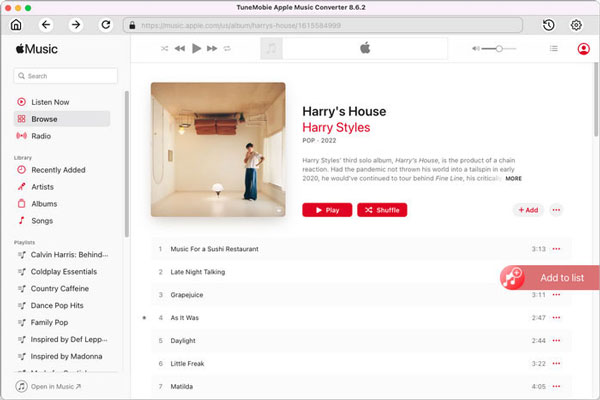
Step 5: Choose Songs
By default, all the songs in the playlist/album will be added in checked status. However, if necessary, you can uncheck the songs you don't want to convert. Music information like title, artist, album, duration and artwork thumbnail will be displayed as well. If the conversion list includes 100 or more songs, you can choose to display 10, 20, 50 or 100 songs per page. If you have converted a part of the album or the playlist and you want to hide the converted songs, you can click "Show All" button and switch to "Hide converted" button.
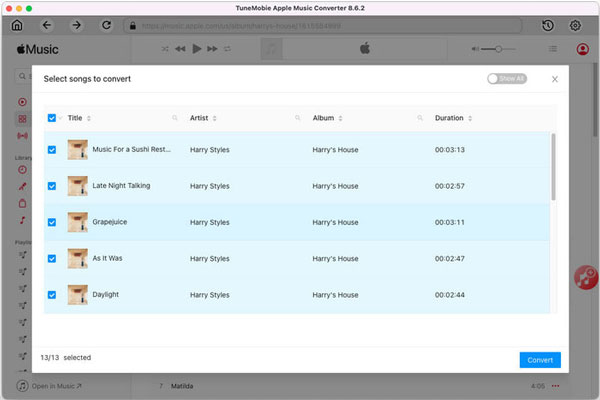
Step 6: Start Apple Music conversion
Now simply click the "Convert" button to start conversion. All the checked Apple Music songs will be converted to MP3, M4A or specific output format at 20X faster speed. It only costs you 10 seconds to convert a 4-minute song.
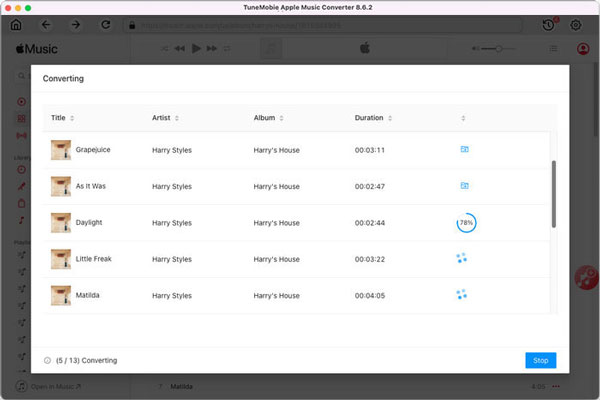
Step 7: Check Conversion History (Optional)
After conversion, you can simply click "History" icon at the upper right corner of software interface to check all the converted songs. The history output songs can be viewed by date, artist or album. If necessary, you can play the songs here and you can delete the history only without deleting the files, or delete both history and local files.
